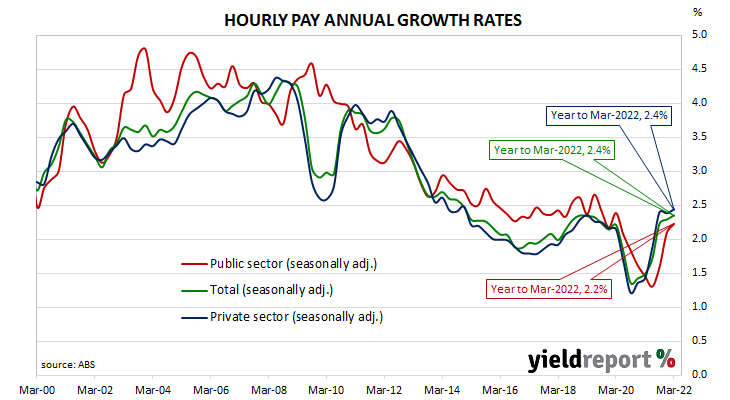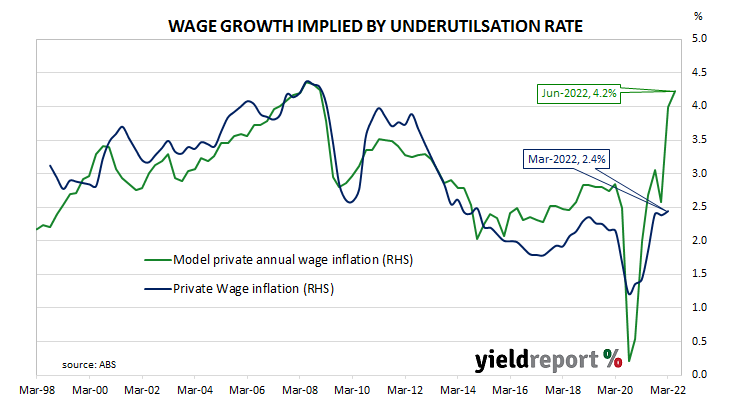Summary: March quarter wages grow by 0.7%, slightly below expectations; annual growth rate ticks up from 2.3% to 2.4%; promising sign of a gathering of momentum in wages; business surveys show labour costs high, rising; private sector wages up 2.4% over year, public sector up 2.2%; ABS underutilisation rate implies higher wage growth coming.
After unemployment increased and wage growth slowed during the GFC, a resources investment boom prompted a temporary recovery back to nearly 4% per annum. However, from mid-2013 through to the September quarter of 2016, the pace of wage increases slowed, until mid-2017 when it began to slowly creep upwards. After remaining fairly stable at around 2.2% per annum from September 2018 to March 2020, the growth rate slowed significantly in the June and September quarters of 2020 before recovering in 2021.
According to the latest Wage Price Index (WPI) figures published by the Australian Bureau of Statistics (ABS), hourly wages grew by 0.7% in the March quarter. The increase was slightly below expectations of a 0.8% rise but in line with the December quarter’s result. On an annual basis, the growth rate ticked up from 2.3% to 2.4%.
“The ABS noted that in the private sector the average rise of those workers getting a pay rise, about 15% of private sector workers, received a 3.4% increase, the largest increase since June 2013,” said Westpac senior economist Justin Smirk. “This is a promising sign we are seeing a gathering of momentum in wages in the private sector.”
Domestic Treasury bond yields moved higher on the day. By the close of business, the 3-year ACGB yield had added 3bps to 3.02%, the 10-year yield had gained 5bps to 3.49% while the 20-year yield finished 8bps higher at 3.83%.
In the cash futures market, expectations of the actual cash rate’s path over time remained largely unchanged. At the end of the day, contract prices implied the cash rate, currently at 0.31%, would rise to 0.575% in June and then rise to 1.425% by August. May 2023 contracts implied a cash rate of 3.355%, 305bps above the current cash rate.
“Notwithstanding the miss in this print, the trend higher is still clear; the labour market is tight with demand indicators suggesting it will tighten further and business surveys are showing that labour costs are high and rising,” said Morgan Stanley Australia equity strategist Chris Read.
Wages in the private and public sectors grew by 0.7% and 0.6% respectively in the quarter. Over the past 12 months, wages in the private sector increased by 2.4% while public sector wages grew by 2.2%. Annual wage growth in the two sectors had been at 2.4% and 2.1% respectively in the December quarter after revisions.
The “underutilisation rate” is simply the sum of the unemployment and underemployment rates as per ABS monthly statistics. It has a good correlation with private wage growth one quarter in the future and thus it is useful as a leading indicator. However, differences can open up from time to time. March’s underutilisation rate suggests private wage growth is likely to accelerate.
Each quarter the ABS surveys around 3,000 private and public enterprises regarding a sample of jobs in each workplace to measure changes in the price of labour across 18,000 jobs. The results are used to construct the Wage Price Index in a manner similar to the construction of the Consumer Price Index (CPI). Changes in the WPI over time provide a measure of changes in wages and salaries, independently of the type or quantity of work.



